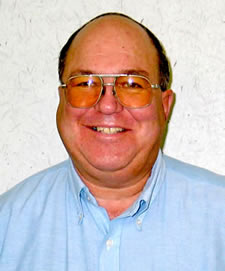By Craig Wilkins
Out of action but not out of touch

Larry Potter, transportation generalist, Baxter truck station. Photo courtesy of District 3 |
The view from Larry Potter’s hospital room on Feb. 25 revealed only falling snow and a faint outline of the hospital’s helicopter landing pad.
Potter was flown to North Memorial Hospital in Robbinsdale Feb.15 after he was struck by a car while working on Hwy 210 near Pillager in Cass County.
Potter was flagging during a crack-sealing operation when a motorist veered into the work zone area.
He is a transportation worker with District 3’s Baxter truck station, but has served with three other districts and as a highway helper in the Twin Cities metro area. Potter’s career with Mn/DOT started in 1975 at the Pipestone truck station in District 8.
Potter suffered multiple fractures of his right leg and injuries to his left knee. Although bed-ridden, he was alert and energetic while following the storm’s progress on television news and weather reports.
“This is the best entertainment I have,” he said.
Potter was quick to add, however, that he’d much rather be plowing his route on Hwy 371 between Brainerd and Nisswa than thinking about it in his hospital bed.
Potter also expressed gratitude for callers and visits by John Lardy, his former FIRST supervisor; Jeff Miller, his current supervisor, and Bob Busch, District 3 transportation engineer.
Support from them and other Mn/DOT employees, friends and family will help his recovery, he said.
“I know that I’m in for a long rehabilitation program,” Potter said, “but I feel as good as I can emotionally and I’m looking forward to coming back to work.”
‘The storm came in waves’

Tim Sand filled his plow’s tanks with brine as he and his co-workers at the Granite Falls truck station geared up for the Feb. 24-25 storms. Photo by Jeff Butson |
At Willmar, the storm set the pattern it would follow across the state.
“The storm came in waves, first with freezing rain and sleet followed by successive snowfalls during Saturday and Sunday,” said Dennis Marty, Willmar sub-area supervisor.
“We did well, better than expected,” Marty said. “The storm started as rain and sleet so we had to apply salt to the ice. When it snowed, we had a good layer of chemicals under the snow.”
Moderate temperatures and the chemicals already applied enabled the district to regain bare pavement on most of its highways by Sunday afternoon, Marty said.
However, the melted snow began to refreeze Sunday evening, so crews were called out once again to apply more de-icing chemicals.
That pattern played out in other areas, including the Twin Cities metro area where hundreds of spin-outs, stalled vehicles and crashes came with the storm.
Metro District crews were out in force to blunt the storm’s effects. Crews went out Thursday applying anti-icing chemicals to pre-treat highways, then started 12-hour shifts to keep highways safe and useable.
Two reasons to scramble the plows: twin premature babies
Life doesn’t stop for snowstorms, especially new life very eager to enter the world.
As they often do, Mn/DOT maintenance workers escorted an ambulance through a storm for a woman to give birth at a hospital.
In this case, crew members from the Little Falls and Baxter truck stations led the way through the dark night for a woman about to deliver a premature set of twins.
Jim Anderson, Brainerd, and Mark Berger, Little Falls, cleared a path from St. Cloud to Crosby where the children were delivered by a neonatologist at the Cuyuna Regional Medical Center.
The twins were born just a few minutes after their arrival.
A nurse at the medical center said the newborns are doing well and have returned to St. Cloud with their parents for continued care.

Bruce Wolf, a seasonal worker at the Dodge Center truck station in District 6, plows Hwy 14 during the Feb. 24-25 storm. Dodge Center had 15 inches of snow, but snowfalls topped two feet in the district’s southeastern corner. Winona received 30 inches of snow. Photo by David Gonzalez |
|



